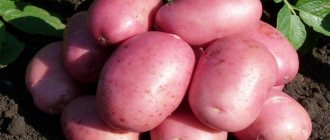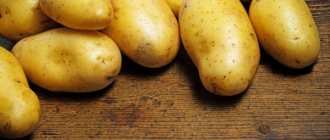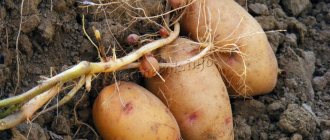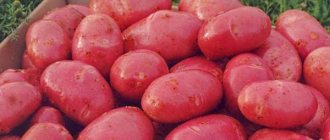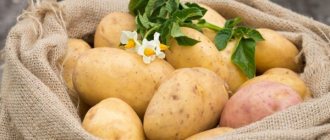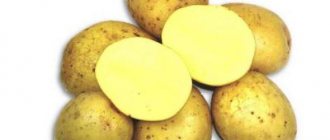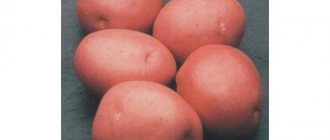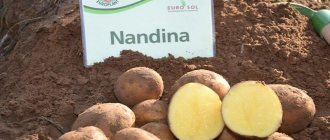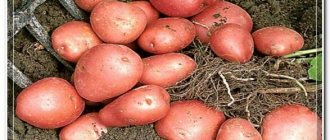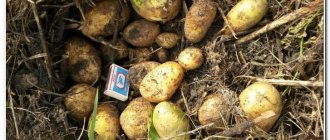What properties do potato varieties differ in?
According to nutritionists and breeders, tubers with skins of different colors differ from each other not only in appearance, but also in chemical composition, as well as technological properties.
Crumbly or dense
Potatoes are usually divided into four types depending on the density of the pulp:
- A - non-cooked, salad type, with minimal starch content;
- B - a slightly boiled variety, used primarily for making chips;
- C - highly boiled, medium-starchy, ideal for deep-frying;
- D - the most starchy, used for purees and casseroles.
There is a direct relationship between the relative density of potatoes and their dry matter content. However, not only the amount of starch in tubers is important, but also the ratio of protein and starch in them. So, if there is 8 times more starch than protein, the vegetable will not boil. If the difference reaches 16 times or more, the potatoes quickly boil over, since they lack adhesives.
Reference. In industrial production, to determine the relative density of tubers, so-called Parov starch scales are used, the operating principle of which is based on Archimedes' law.
Starch content
Starch makes up 70-80% of all tuber dry matter. There are two main categories for this indicator:
- Mealy potatoes with a high starch content (16-22% by weight of the tuber). The pulp is dry and flaky; when cooked, it acquires a granular texture.
- “Waxy” varieties feel watery when exposed to heat; they hold their shape well when heated.
Reference! Late-ripening varieties are the starchiest, since over a longer growing season they accumulate more sugars than early-ripening ones.
The amount of starch is an unstable indicator, depending on growing conditions, storage duration, tuber size and other factors. Therefore, fluctuations within 5% are permissible for the same variety.
- young, freshly dug potatoes will be waxier than fully mature ones;
- small and large tubers contain less starch than medium-sized ones;
- During storage, hydrolytic decomposition of starch to sugars occurs.
Reference! When starchy potato varieties are cooked, intercellular connections are weakened, which is why the tuber loses its structural unity. A similar splitting reaction also occurs in waxy potatoes, but at higher temperatures. The difference is almost 12°C.
Taste qualities
The taste of a product is determined by such an objective indicator as its chemical composition. However, the perception of taste is subjective and depends on the characteristics of the national cuisine, individual preferences and even the arguments of commercial advertising.
The taste of potatoes is affected by starch and sugars (glucose and lactose), protein, fatty acids, mineral elements, the so-called “dry protein” - nitrogenous compounds, etc.
The presence of fatty acids in tubers - glutamic and aspartic - during cooking contribute to the formation of volatile compounds that affect taste buds. Another group of substances responsible for taste are nucleotides, the so-called breakdown products of nucleic acids. The more there are, the richer the potato bouquet.
The chemical composition largely depends on agricultural technology:
- The absence of mineral supplements during potato growing has a beneficial effect on taste. Ideally, if only humus and ash were added to the soil, such a crop is recommended for dietary and baby food.
- Watery pulp is often due to excess nitrogen and lack of potassium. Excessive feeding with nitric acid salts or slurry, although it increases yield, but leads to the accumulation of nitrates in tubers. Such potatoes often have an off-odor, and their flesh quickly turns black.
Certain changes in taste are associated with improper storage:
- at low temperatures (from 0 to +1°C), starch turns into sugar, and potatoes acquire an unpleasant sweetish taste;
- bitterness occurs if the tubers have been exposed to light for a long time and have turned green, as a result of which a glycoalkaloid, solanine, accumulates in them.
In small quantities, solanine is safe and gives potatoes their characteristic flavor. If the concentration of the substance is only 50-100 mg per 1 kg of vegetable, potatoes are perceived as tasty. You can reduce the amount of glycoalkoloids by simply peeling and boiling the tubers.
Attention! Signs of solanine poisoning occur when a person consumes 400 mg of the substance at a time. In addition to potatoes, it is found in all nightshade crops, including tomatoes and eggplants.
Optimal varieties for frying
So, let's look at several varieties of tuber crops that are presented on the Russian market and are in demand among farmers. It should immediately be noted that there are no varieties intended only for frying, but there are varieties with a relatively low starch content and universal varieties suitable for a wide range of culinary dishes and other consumer purposes. We tried to highlight several of these varieties, out of hundreds of others, for you.
There are two factors that determine the texture of potatoes after cooking: their solids content and their starch content. Potatoes with a low solids content have a moist texture, while potatoes with a high solids content are drier and crumbly.
Luck
A domestic variety loved by Russians, it confirms its name with high yields even in unfavorable years. With a spreading, densely leafy above-ground part of the bush, up to 40 cm.
The tubers are creamy or light brown in color, quite large in size - up to 150 g, starch content up to 14%. The consistency of the pulp is moderately dense, not watery, white, when cooked it acquires a yellowish tint and retains its shape well.
The taste is at a high level. In addition, the variety has good versatility and is suitable for both baking and frying.
Nevsky
A domestic selection recognized by farmers, with an average ripening period and low starch content—up to 10%. Dense, low aboveground part.
The tubers are yellow in color, elongated oval in shape, up to 140 g. The pulp is creamy in color, does not darken for a long time when cut and retains its shape during heat treatment.
Thanks to its fullness of taste, this variety is recognized among gardeners. Another advantage is its versatility, which makes the variety suitable for preparing first courses and frying.
Romano
A potato variety with a 75-day ripening period and high yields, bred by Dutch breeders. Erect, dense tops of medium height.
The starch content is up to 17%, so the flesh practically does not darken when cut. Tubers are small in size, up to 80 g, with soft pink skin.
The pulp is fine-grained, dense, with a yellowish tint, not watery. It has balanced taste. Keeps its texture dense when preparing dishes, suitable for frying and casseroles.
cornflower
Russian variety with a medium ripening period. The aboveground part is of medium height, not spreading.
Starch content is up to 16%, the flesh does not darken when cut and cooked. Tubers are oval, elongated, up to 130 g, with a blue-violet skin, the color of which disappears during heat treatment. The pulp is cream-colored, homogeneous and dense, not watery, with low mealiness. The variety has a neutral potato taste and a high content of vitamins A and E.
The versatility of the variety for table use and moderate cooking ability make it suitable for preparing a wide range of dishes: from fried and baked, to first courses and purees. It is popular for preparing baby and diet food.
What is special about white potato varieties?
There is an opinion that potatoes with white skin contain more starch and boil quickly . This stereotype has a historical background: for a long time foreign “red-skinned” varieties were unknown in Russia; they came into wide use only in the 1990s.
Foreign consumers, due to culinary traditions, prefer poorly cooked potatoes. Our compatriots, on the contrary, have always appreciated hearty, starchy potatoes. As a result, imported red and pink varieties are still perceived as “waxy”, while the more familiar white varieties are still perceived as “floury” (starchy).
However, selection has erased the clear differences between potatoes with different shades of skin. Taste and technological qualities are individual for specific varieties.
Lorch is distinguished by high and increased starchiness with an indicator of 15-20%, Temp - 16-22% and some others. Also among the “white-skinned” varieties there are low-starch varieties: Impala - 10-14%, Udacha - 12-14%, Karatop - 12-14%.
The color of the pulp is more indicative. Thus, a yellow tint indicates the presence of carotene, that is, vitamin A, in the tubers: the more saturated it is, the higher the content of the substance. For example, in 100 g of raw potatoes with white flesh there are 14-53 mg of carotenoids, with cream and light yellow flesh - 150-400 mg, and in Peruvian potatoes with dark yellow flesh - 1700-2000 mg.
As a rule, yellow potato varieties are not very boiled, moderately sweet and pleasant to the taste. One of them - Gala - is suitable for dietary nutrition due to its low starch content - only 10.2 - 13.2%.
The best potato varieties in terms of taste, domestic and foreign selection
Often people prefer to grow certain varieties in different areas. The most delicious potato varieties for the Moscow region are Udacha, Karatop; in areas of this zone, Priekulsky early, Lorch, Rozara, Zhukovsky early, Zhuravinka are grown. For Siberia - Adretta, Lugovskoy, Scarlett, as well as several others - Timo, Udacha, Zhukovsky early, Alena.
The most delicious potato varieties in Ukraine are Impala, Sineglazka, Bellarosa, Picasso, Concord, Rosara. In Belarus they like to plant not only Dutch varieties, but also their own Belarusian ones - Skarb, Breeze, Vektar, Lasunak.
What is special about red potato varieties?
The bright color of the peel is achieved due to the high content of anthocyanins in the tubers. These substances are extremely beneficial as they have antioxidant properties and help the body resist the harmful effects of ultraviolet radiation and free radicals. In addition, anthocyanins increase the elasticity of vessel walls, accelerate collagen synthesis, and strengthen the retina.
The first imported varieties of red potatoes brought to Russia contained less starch than the usual light-skinned tubers. Some of the nicknames have remained so to this day: the pink variety of Russian selection Zhukovsky early with 10-12% starch, the Dutch Red Scarlett with 10-15%. They are distinguished by their wateriness and stability of shape during heat treatment.
The red varieties Symphony are rich in starch - 14-19%, Crimean Rose - 16-18%, Condor - about 18%, Rocco - 19.7%, Zdabytak - 19.2 - 25.4%.
The most crumbly varieties of potatoes for mashed potatoes
Who doesn't love crumbly boiled potatoes? Or fragrant mashed potatoes? Just real puree, not the sticky mass that often comes from store-bought potatoes. How about nutritious creamy potato soup?
These seemingly simple dishes will not be tasty without crumbly, soggy potatoes. Therefore, we draw your attention to the following varieties:
Tiras
An early variety of Ukrainian selection. Ripens in 55-70 days. The peel is pink, the flesh is white. Starch content: 12-13%. When cooked, it softens well. The variety is resistant to potato cancer, golden potato nematode, and scab. Moderately resistant to late blight. Well kept.
Sineglazka
Mid-early Russian variety. Ripens in 65-80 days. The peel is pink-gray with a purple tint, the flesh is white. Starch content: 15-15.5%. It is crumbly and very tasty (for which it is valued by gardeners); when cooked, it becomes medium soft. The variety is moderately resistant to all major potato diseases. It does not differ in keeping quality, it is advisable not to store it for a long time. Nowadays it is not easy to find a real blue-eye. The variety is very old, but loved by everyone for its unique taste.
Charoite
An early variety of Russian selection. Ripens in 50-65 days. The peel is yellow, the flesh is pale yellow. Starch content: 14-17%. When cooked, it softens well and is ideal for purees and baking. The variety is resistant to potato blight. Moderately resistant to late blight and viruses. Well kept.
Riviera
Early Dutch variety. The tubers reach full maturity 75-80 days after planting, but you can dig up the tubers already on the 45th day. The peel is light beige, the flesh is creamy. Starch content 11-16%. The boilability is average, but it’s perfect for purees. The variety is resistant to potato cancer, nematodes, and viral diseases. It is not resistant to late blight and scab, but due to early ripening it can avoid these diseases. Well kept.
Bellarosa
Early German variety. Ripening time is 50-60 days. The peel is pink, the flesh is light yellow. Starch content: 12-16%. Very crumbly, boils perfectly. The variety is resistant to all major potato diseases, including late blight. Keeping quality is good. One of the best early potato varieties according to reviews from gardeners.
Which potatoes are suitable for frying?
Some chefs argue that the varieties that contain the least starch are suitable for frying: the pieces should retain their shape when they are mercilessly mixed in a frying pan. Others are convinced that starch molecules help the formation of a golden brown crust, and the dense pulp prevents the oil from absorbing too deeply.
The reason for the disagreement lies in the different frying methods. French fries require starchy (flour) varieties. If the potatoes are cooked in a frying pan with a small amount of oil added, they should hold their shape well, i.e. in this case, “waxy” tubers are welcome. To prevent the slices from crumbling, they must contain enough sticky substance - pectin.
Reference. Potatoes with low water content are suitable for deep frying. The moisture in the boiling oil quickly evaporates, leaving a crispy crust on the surface and well-steamed flesh inside.
What type of potatoes are suitable for boiling and mashing
Potatoes are boiled for different purposes: for making soups, salads and purees.
In salads and soups, varieties are used whose starch content does not exceed 15%. These potatoes have thin skin and watery flesh; after cooking, the tubers retain their shape.
A starch content of 16% and above is a necessary condition for puree that melts in your mouth. Starch actively absorbs moisture, so to prevent the dish from tasting too dry, add a lot of milk and butter. This increases the calorie content of the dish significantly, but makes the puree especially tasty.
Tips and tricks
The less dry matter there is in potatoes, the more resistant it is to high temperatures. In cooking, this means that non-starchy potatoes hold their shape better, the slices do not fall apart when stirred, and the pulp absorbs less moisture. These varieties are suitable for salads, soups and frying in a pan. Varieties with bright red skin have the listed properties.
Vegetables with a high starch content have proven themselves well for making mashed potatoes and deep-fried potatoes, as well as for baking.
